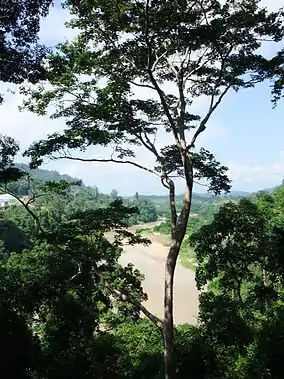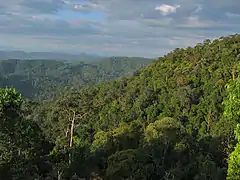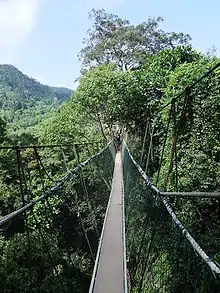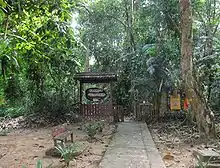Taman Negara
Taman Negara is a national park in Peninsular Malaysia. It was established in 1938/1939 as the King George V National Park after Theodore Hubback lobbied the sultans of Pahang, Terengganu and Kelantan to set aside a piece of land that covers the three states for the creation of a protected area.[1] It was renamed Taman Negara after independence, which means "national park" in Malay. Taman Negara has a total area of 4,343 km2 and it is one of the world's oldest deciduous rainforests, estimated to be more than 130 million years old.[2][3]
| Taman Negara | |
|---|---|
| King George V National Park | |
IUCN category II (national park) | |
 View of Sungai Tembeling from atop the canopy walkway. | |
 | |
| Location | Malaysia |
| Nearest city | Kuala Tembeling |
| Coordinates | 4°42′N 102°28′E |
| Area | 4,343 km2 (1,677 sq mi) |
| Established | 1938/1939 |
| Governing body | Department of Wildlife and National Parks |
Attractions found near Kuala Tahan (where the Park headquarters for Pahang is located) include a canopy walkway, the Gua Telinga cave system, and the Lata Berkoh rapids. Visitors can experience the tropical rainforest, birdwatching or jungle trekking (e.g. Tenor Rentis) and the river views along the Tahan River.
Geography

The park encompasses three states, Pahang, Kelantan and Terengganu, each with its own legislation. The Taman Negara Enactment (Pahang) No. 2 of 1939 is enforced in the state of Pahang, the Taman Negara Enactment (Kelantan) No. 14 of 1938 in the state of Kelantan and the Taman Negara Enactment (Terengganu) No. 6 of 1939 in the state of Terengganu. The enactments have similar contents.[1]
Taman Negara Pahang is the largest at 2,477 km2, followed by Taman Negara Kelantan at 1,043 km2 and Taman Negara Terengganu at 853 km2. At an estimated age of more than 130 million years old, it is reputed to be the "oldest tropical rainforest", although the title more accurately belongs to the Daintree Rainforest in Queensland, Australia, estimated to be between 135 million years old [4] and 180 million years old.[5]
The park has been developed into an ecotourism destination in Malaysia. There are several geological and biological attractions in the park. Gunung Tahan is the highest point of the Malay Peninsula; climbers can use Kuala Tahan or Merapoh[6] as their departure point. All visitors to the park must obtain permits from the Department of Wildlife and National Parks.
Forests pump out oxygen we need to live and absorb the carbon dioxide we exhale (or emit). A single mature, leafy tree is estimated to produce a day's supply of oxygen for anywhere from two to 10 people. Phytoplankton in the ocean are more prolific, providing half of Earth's oxygen, but forests are still a key source of quality air.
Trees also have another way to beat the heat: absorb CO2 that fuels global warming. Plants always need some CO2 for photosynthesis, but Earth's air is now so thick with extra emissions that forests fight global warming just by breathing. CO2 is stored in wood, leaves and soil, often for centuries.
Fauna

Taman Negara is home to some rare mammals, such as the Malayan tiger,[7] Malayan gaur (seladang) and Asian elephant. As well as birds such as the great argus, red junglefowl, and the rare Malayan peacock-pheasant are still found here in some numbers. Tahan River has been preserved to protect the Malaysian mahseer (ikan kelah in Malay), a type of game fish.
Transportation

Keretapi Tanah Melayu (KTM)'s KTM Intercity and Express trains stop at Jerantut railway station. Visitors to Taman Negara can disembark here.
Local tour operators arrange transportation from Kuala Lumpur to the entrance of the Park at Kuala Tahan. This may involve a 3-4 hour bus journey to Jerantut and Kuala Tembeling Jetty followed by a 2.5 hour river boat ride to Kuala Tahan.[8] Entrance permits and park tours are often included in the package.
From Kuala Lumpur, buses may depart from Terminal Bersepadu Selatan and Hentian Pekeliling going to the nearest town, Jerantut. From here travel to Kuala Tembeling Jetty and Kuala Tahan.[9]
See also
- List of national parks of Malaysia
- Gunung Tahan highest point in peninsula Malaysia.
References
- Pakhriazad., H.Z , Mohd. Hasmadi, I. & Aida, H.M.K (March 2009). "Historical and Current Legislations of Taman Negara National Park, Peninsular Malaysia". Journal of Politics and Law. 2 (1).CS1 maint: uses authors parameter (link)
- "Walking the Canopy of the World's Oldest Rainforest -- Malaysia's Taman Negara". www.highonadventure.com.
- "Taman Negara Travel Guide - Malaysia Travel Guide". travelmalaysiaguide.com.
- https://www.transfercarus.com/blog/travel-tips-us/jungle-surfing-in-the-oldest-rainforest-in-the-world
- Lloyd, Graham (August 22, 2011). "The Oldest Rainforest". The Australian.
- "Archived copy". Archived from the original on 2012-09-14. Retrieved 2013-03-31.CS1 maint: archived copy as title (link)
- Kawanishi, K.; Sunquist, M. E. (2004). "Conservation status of tigers in a primary rainforest of Peninsular Malaysia". Biological Conservation. 120: 329–344. doi:10.1016/j.biocon.2004.03.005.CS1 maint: multiple names: authors list (link)
- "Shuttle Services (Bus/Van/Boat)". Taman Negara.
- "Transport". Taman Negara.
10. ↑ KL to Taman Negara shuttle service
External links
| Wikimedia Commons has media related to Taman Negara National Park. |
 Taman Negara travel guide from Wikivoyage
Taman Negara travel guide from Wikivoyage- Tourism Malaysia - Taman Negara
- Department of Wildlife and National Parks
- Jerantut KTM Railway Station